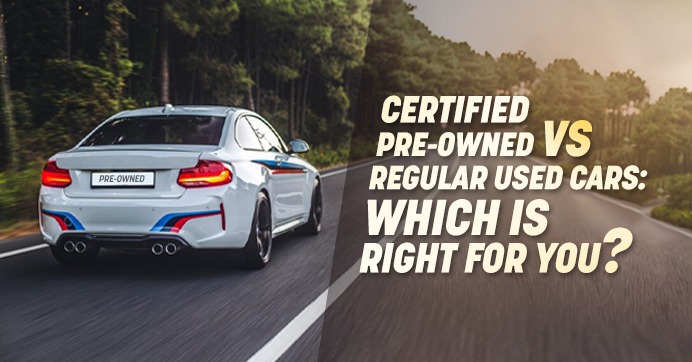Certified Pre-Owned vs Regular Used Cars: Which Is Right for You?
When it comes to purchasing a used car, you'll often encounter two primary options: certified pre-owned (CPO) vehicles and regular used cars. Each option has its own set of advantages and considerations. In this blog, we'll dive into the differences between certified pre-owned and regular used cars to help you make an informed decision that aligns with your needs, preferences, and budget.
- Quality Assurance:
- Extended Warranty:
- Low Mileage:
- Vehicle History Report:
- Roadside Assistance:
Certified Pre-Owned (CPO) Cars
Certified pre-owned cars are used vehicles that have undergone a rigorous inspection and refurbishment process by the manufacturer or an authorized dealership. These cars typically come with additional benefits and assurances compared to regular used cars.
Advantages of CPO Cars:
CPO cars undergo a comprehensive inspection and refurbishment process, ensuring that they meet high-quality standards set by the manufacturer. Any necessary repairs or maintenance are performed before the car is certified.
CPO cars often come with an extended warranty, providing peace of mind by covering certain repairs and maintenance costs for an extended period.
CPO cars typically have lower mileage compared to regular used cars of the same age, which can prolong the vehicle's lifespan and reduce potential repair expenses.
CPO programs often include a thorough vehicle history report, allowing buyers to review the car's maintenance and accident history.
Many CPO programs include 24/7 roadside assistance, ensuring help is available in case of unexpected breakdowns or emergencies.
Considerations for CPO Cars:
- Higher Price:
- Limited Selection:
Certified pre-owned cars tend to be more expensive than regular used cars due to the added benefits and assurance they provide.
The availability of CPO vehicles may be limited to specific makes and models offered by participating manufacturers or dealerships.
Regular Used Cars
Regular used cars encompass a wide range of vehicles that are sold as-is or after minimal inspection and refurbishment, often by private sellers, independent dealerships, or through online listings.
Advantages of Regular Used Cars:
- Lower Cost:
Regular used cars are generally more affordable upfront compared to their CPO counterparts, making them an attractive option for budget-conscious buyers.
- Diverse Selection:
The used car market offers a vast selection of makes, models, and price ranges, giving buyers more flexibility to find a car that meets their specific needs.
- Room for Negotiation:
Buyers may have more room for negotiation when purchasing a regular used car, potentially securing a better deal.
Considerations for Regular Used Cars:
- Uncertain History:
Regular used cars may have an unclear maintenance and accident history, requiring buyers to conduct thorough research and obtain a vehicle history report independently.
- Limited Warranty:
Unlike CPO cars, regular used cars often come with limited or no warranty coverage, leaving buyers responsible for repair costs.
- Higher Maintenance Costs:
Older regular used cars may require more frequent maintenance and repairs, which can add to the total cost of ownership over time.
Which Is Right for You?
- Lower Cost:
- Diverse Selection:
- Room for Negotiation:
Regular used cars are generally more affordable upfront compared to their CPO counterparts, making them an attractive option for budget-conscious buyers.
The used car market offers a vast selection of makes, models, and price ranges, giving buyers more flexibility to find a car that meets their specific needs.
Buyers may have more room for negotiation when purchasing a regular used car, potentially securing a better deal.
Considerations for Regular Used Cars:
- Uncertain History:
Regular used cars may have an unclear maintenance and accident history, requiring buyers to conduct thorough research and obtain a vehicle history report independently.
- Limited Warranty:
Unlike CPO cars, regular used cars often come with limited or no warranty coverage, leaving buyers responsible for repair costs.
- Higher Maintenance Costs:
Older regular used cars may require more frequent maintenance and repairs, which can add to the total cost of ownership over time.
Which Is Right for You?
- Uncertain History:
- Limited Warranty:
- Higher Maintenance Costs:
Regular used cars may have an unclear maintenance and accident history, requiring buyers to conduct thorough research and obtain a vehicle history report independently.
Unlike CPO cars, regular used cars often come with limited or no warranty coverage, leaving buyers responsible for repair costs.
Older regular used cars may require more frequent maintenance and repairs, which can add to the total cost of ownership over time.
Which Is Right for You?
The choice between a certified pre-owned car and a regular used car ultimately depends on your priorities and budget:
If you prioritize peace of mind, quality assurance, and are willing to pay a premium for it, a certified pre-owned car may be the right choice for you.
If you're on a tight budget and comfortable with conducting thorough research and inspections, a regular used car can offer excellent value, provided you're prepared for potential maintenance expenses.
Remember to carefully evaluate your needs, research available options, and consider factors like warranty coverage, budget constraints, and your risk tolerance when deciding between certified pre-owned and regular used cars. Whichever option you choose, a well-informed decision will lead to a satisfying and reliable used car purchase.

